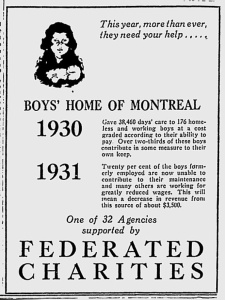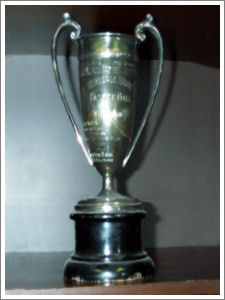Charles Alexander survived a shipwreck to become one of Montreal's leading philanthropists, and founder of the Boys' Home of Montreal which later became Weredale House.

Born in Dundee, Scotland, in 1816, Charles Alexander attended grammar school and was apprenticed to the firm of Keiller and Sons, marmalade manufacturer. In 1840, he sailed for Canada with his wife and son to work for the firm’s Montreal establishment. On board he learned the skills of sailor, rope-spinner and ship's cook. Their ship ran aground and sank at Torbay, Newfoundland, and although the Alexanders were rescued, they lost almost everything they owned - "except", according to one source, "a recipe for candy."
Having worked for a year in London, Upper Canada, Alexander returned to Montreal and managed to borrow £4,500 by 1842 with which he opened a confectionery and the city’s first temperance dining-room on McGill Street. He later added an ice-cream parlour and pioneered catering services in the city. His debt was paid within a couple of years, and the establishment grew, shifting to steam power by 1871. A hardworking and honest businessman, Alexander played an important role in the city as a reformer and a philanthropist. Elected to both City Council and the Quebec Legislature, he lobbied for sanitary and prison reform.
No stranger to hardships, C. Alexander regarded his good fortune as a means to help the unfortunate. In 1863 he was among the group of city elite who founded the Montreal Protestant House of Industry and Refuge and served as its president from 1877 to 1900 as well as a manager on the United Board of Outdoor Relief that worked under its auspices. He was also a founding member and vice-president of the Society for the Protection of Women and Children and founding president of the Institute for Protestant Deaf Mutes and the Blind (Mackay Institute). As a humanist he worked for many causes. He was a founding member and later president of the Canadian Society for the Prevention of Cruelty to Animals, a founding member and vice-president of the Montreal Sailors' Institute, a founding member and vice-president of the Protestant Hospital in Verdun and of the Montreal Homeopathic Hospital. He served on the management committees and as vice-president of the Montreal General Hospital, as vice-president of the Canadian Institute and as treasurer of the Sheltering Home.
In 1870, Charles Alexander and a small group from Zion Congregational Church founded the Boys' Home. Alexander paid for the building on Mountain Street near St. Antoine, "between the railway stations", at a cost of $18,000. Originally designed for newsboys, admissions on the first day included eight orphans rescued from the streets and four brothers whose father had a drinking problem.

John Dougall, owner-editor of the Montreal Daily Witness, his son John Redpath Dougall and James Baylis, were also associated with the project. Mr. Baylis was vice-president until his death in 1899, and J.R. Dougall became president following Alexander’s death in November, 1905.
As an institution originally run by non-conformist Protestants, the Boys’ Home was supported by a number of the city’s elite and entries for many gifts "in kind" appear on the books. Used clothes helped keep down costs while donations of holiday foods were greatly appreciated as were special treats like "rhubarb and sugar" and practical gifts like "repairs to clock."
In 1870, all of the boys were working, most of them in city trades. Night classes were added immediately as long as space allowed. The new wing in 1893 included dedicated classrooms; in 1901 manual training classes were introduced thanks to Sir William Macdonald. In 1905 the Alexander Wing added a swimming pool, gymnasium and a larger dining-room.
In the twentieth century the overall demand for admission to the home increased. Most of the boys worked but a growing number were attending local schools. Both the age of the buildings and the need for larger quarters led the Board to appeal for help with a new building. By 1930, the Rotary Club of Montreal mounted a campaign to this effect and raised $289,000. A new Home was built in Weredale Park. There were substantial improvements and additions made in 1946 and 1956.
Boys had been attending a shared camp in Ste. Marguerite from the 1920s but in 1934, the Rotary Club of Westmount bought 260 acres, with a mile of shoreline, on Lac l'Achigan, 55 miles north of Montreal, and gave the property to Weredale House. Here, Camp Weredale was established, to serve as a summer home for the boys and the staff.
Written by Janice Harvey of Dawson College

